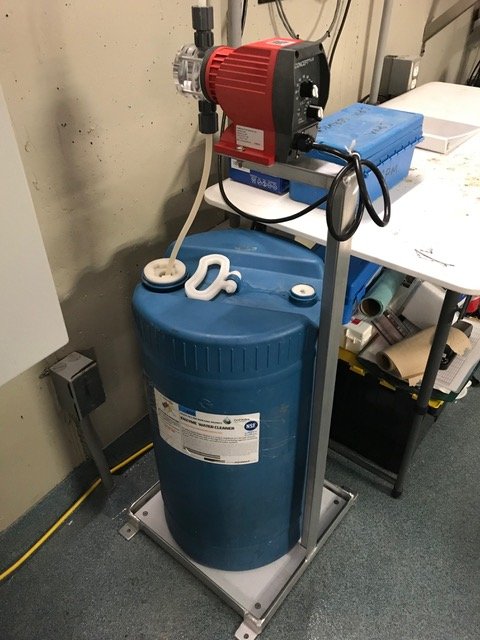Simplify Pool Chemistry
Improve your IAQ with these tips below.
This is a guest post by Eric Knight with Orenda Technologies.
Commercial swimming pools require a lot of maintenance and day-to-day monitoring. The good ones have chemical automation systems, quality filtration and circulation systems, and secondary sanitization systems like UV or Ozone. There are many moving parts, and to a swimming pool operator, it can seem overwhelming. I know, because I was once a commercial pool operator myself. It was daunting.
When it comes to pool chemistry, we can subdivide the topic into two categories: sanitization, and water balance.
SANITIZATION
Sanitization, in my opinion, is the easy part. This is keeping the water clean, safe, and sanitized. For most commercial pools, this is primarily accomplished with chlorination. Chlorine residuals are maintained by staying ahead of what is called “the breakpoint”, where combined chlorine is destroyed to a point where it can no longer be reduced. Provided water maintains a healthy free chlorine residual, it should be safe to swim in. At least, in theory.
In reality, there are many other demands put on chlorine. In other words, we rely on chlorine to do more things than it was designed for. Chlorine is an outstanding sanitizer/disinfectant. But most of it gets used up oxidizing non-living bather waste. Compared to its strength as a germ killer, chlorine is a relatively weak and inefficient oxidizer. It gets bogged down, which can lead to cloudy water, higher levels of combined chlorine, and more chlorine consumption.
Another important aspect of sanitization is preventing outbreaks in the first place. Elements like phosphorus (in the form of phosphates in water) are nutrients for algae and other microorganisms. Without removing phosphates, your water is relying on killing reproducing generations of algae and other nasties. When the reproduction/growth rate of the contaminant exceeds the killing rate of your chlorine + secondary sanitizers, you will have an outbreak.
CV-600 Enzyme on Feeder
Proactive Chlorine Supplementation
We can simplify and optimize sanitization by supplementing chlorine. We recommend supplementing it in two ways. First is the use of enzymes that break down and remove non-living organic waste (bather waste). This relieves chlorine of its massive burden to oxidize the bather load. With enzymes, less chlorine is needed to conquer the demand, and therefore more chlorine is available as a residual to disinfect the water.
Second, we recommend removing phosphates regularly. Removing phosphates reduces the nutrients available for reproduction of algae and other living contaminants. It won’t kill anything, but it will slow the growth. When done right, the growth/reproduction rate will remain slower than the killing rate of chlorine, which prevents outbreaks.
Both strategies use simple, NSF-50 Certified chemicals to supplement chlorine.
Orenda’s free mobile app calculates LSI for you.
WATER BALANCE
Orenda’s free mobile app calculates LSI for you.
Outside of sanitization, the rest of water chemistry is about balance. And when we say “balance”, we are talking about the saturation level of calcium carbonate (CaCO3). This saturation balance is measured using the Langelier Saturation Index (LSI). We built a free mobile app that calculates the LSI for you (download here on iOS or Android). The LSI takes six factors into account: pH, carbonate alkalinity, calcium hardness, water temperature, total dissolved solids (TDS), and cyanuric acid (CYA).
So if you’re only testing for chlorine, pH and [sometimes] alkalinity, you’re still missing half the equation! The LSI is what water cares about…not ranges of chemistry printed in a textbook.
So balance water according to the LSI, and you might be shocked at how well the water behaves. Prepare to be pleasantly surprised at how much less you spend on chemicals to keep pH and alkalinity adjusted. Think about it. Think of all the chemicals used in swimming pools just to manage pH and alkalinity. Acid(s), CO2, sodium bicarbonate, sodium carbonate (soda ash), etc.. Wouldn’t it be nice if those factors fluctuated less? With an LSI-focused strategy, it can happen.
Proactive Water Balance Techniques
Embrace calcium as your friend, not your enemy. Pool operators assume calcium hardness is the primary driver of carbonate scale formation…but that’s not true. The LSI shows us that calcium hardness is far less of a factor than pH and even water temperature. Elevated levels of calcium hardness (400 ppm +) can be to your advantage! Water cannot over-saturate itself, so if you use calcium and alkalinity to create a balanced environment, pH tends to become more steady.
Stay within -0.30 to +0.30 on the LSI, and ideally 0.00 to +0.30. On the Orenda app, the ideal zone is an LSI value that is green. If you just maintain water chemistry in that zone every time you treat the water, you’re doing a great job.
CONCLUSION
I hope this article helps you simplify your pool chemistry. On the sanitization side of water chemistry, supplement chlorine with enzymes for bather waste, and phosphate remover for reducing nutrients. For water balance, learn the LSI and build your chemistry strategy around it.
Eric Knight is a former competitive swimmer that developed asthma from swimming indoors. He is in the aquatics industry primarily to fix indoor air quality problems in natatoriums, and currently works for Orenda Technologies. www.orendatech.com.
—–





